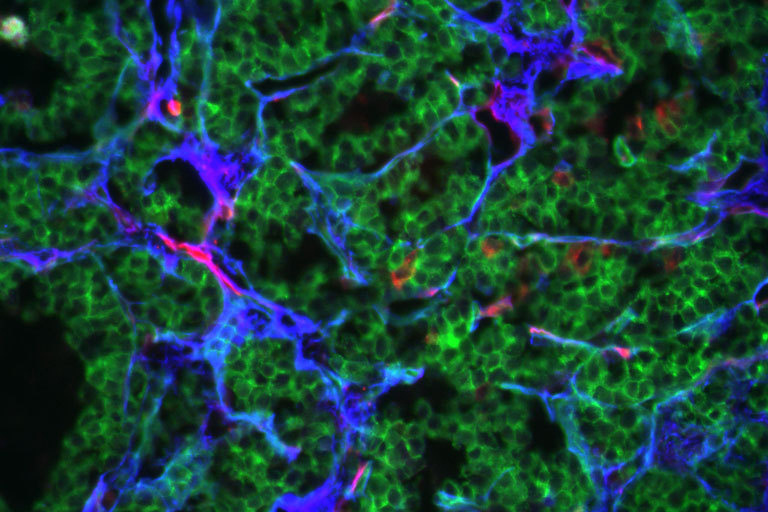
Deposits of fibronectin (blue) around the vasculature in the extracellular matrix of a pancreatic tumor.
Image Credit: Patrick Murphy, Hynes Lab
PNAS
October 11, 2019
Pancreatic cancer is one of the most challenging tumors to treat, and patient survival rates remain quite low. A hallmark of the disease is tough, highly fibrotic stroma, or connective tissue, that makes up a significant part of the tumor mass and can form a barrier that hampers immune cell access, compromises drug delivery, and promotes resistance to chemotherapies and other drugs. However, clinical trials of therapies that generally target this fibrotic tissue have shown that such broad approaches are not enough to overcome treatment challenges and can even accelerate disease progression.
A major component of the stroma is extracellular matrix (ECM), a network of proteins that surrounds a tumor, providing both physical support and biochemical cues that can contribute to tumor progression and metastasis. ECM is of long-standing and increasing interest in cancer research, particularly in pancreatic tumors, where it is known to play a role that is important, but poorly understood.
Sorting out the composition and changes of the ECM during pancreatic cancer progression, as well as the respective contributions of stromal and tumor cells to the matrix, could inform the development and application of more precise PDAC therapies. A new study in Proceedings of the National Academy of Science, performed by researchers in the laboratory of Richard Hynes, Daniel K Ludwig Professor of Cancer Research and professor of biology, provides the most comprehensive analysis yet of ECM proteins in pancreatic disease, and builds on the group’s earlier work on tumor ECM, which revealed previously unknown cancer promoters.
In the new research, the team used quantitative mass spectrometry-based proteomics analysis to study ECM proteins in normal, pre-cancerous, and cancer cells from both human patients and mouse genetic models, as well as chronic pancreatitis patient samples, and to examine systematically, for the first time, the composition and dynamics of ECM proteins during pancreatic cancer progression.
Among their findings, the researchers describe early changes in matrix proteins, beginning at the pre-cancer stage, which could potentially be used for early detection biomarkers.
Additionally, they showed that, although stromal cells produce over 90% of the ECM mass, it is actually high levels of ECM proteins derived from the tumor cells, not those produced only by stromal cells, that correlate with poor patient survival. This is indeed, a case of a few bad apples spoiling the bunch.
Furthermore, the researchers’ analyses implicated distinct pathways in regulating expression of ECM proteins in cancer cells and stromal cells. Their findings suggest that precise ECM manipulations, such as targeting tumor-promoting ECM proteins and their regulators in cancer cells, could be more effective therapeutically than general suppression of ECM production.